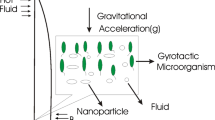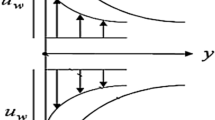Abstract
Nanofluid dynamics with magnetohydrodynamics has tremendously contributed in industrial applications recently since presence of nanoparticle in base fluids enhances the specific chemical and physical properties. Owing to the relevance of nanofluid dynamics, we analyze the nanofluid flow in the presence of gyrotactic microorganism and magnetohydrodynamics through a stretching/shrinking plate. The impacts of chemical reaction and thermal radiation on flow characteristics are also studied. To simplify the governing equations of microorganisms, velocity, concentration and temperature, the similarity transformations are employed. The couple governing equations are numerically solved using Successive Taylor Series Linearization Method (STSLM). The velocity profile, motile microorganism density profile, concentration profile, temperature profile as well as Nusselt number, skin friction coefficient, Sherwood number and density number of motile microorganisms are discussed using tables and graphs against all the sundry parameters. A numerical comparison is also given for Nusselt number, Sherwood number, skin friction, and density number of motile microorganisms with previously published results to validate the present model. The results show that Nusselt number, Sherwood number and density number diminish with increasing the magnetic field effects.











Similar content being viewed by others
Abbreviations
- \(\bar {B}_{0}\) :
-
Magnetic field (T)
- x\(\bar {u}\bar {v}\) :
-
Components of velocity (m/s)
- \(\tilde {\alpha } \) :
-
Thermal conductivity (W/mK)
- \(D_{\bar {T}}\) :
-
Thermophoretic coefficient
- K c :
-
Chemical reaction parameter
- S c :
-
Schmidt number
- S b :
-
Bioconvection Schmidt number
- M :
-
Magnetic field parameter (T)
- S :
-
Suction/injection parameter
- \(\bar {T}_{w}\) :
-
Temperature of the wall (K)
- \(\bar {T}_{\infty } \) :
-
Ambient temperature (K)
- 𝜃 :
-
Temperature profile (K)
- ϕ :
-
Concentration profile (mol/m3)
- \(\bar {C}_{w}\) :
-
Concentration at the wall (mol/m3)
- \(\bar {C}_{\infty } \) :
-
Ambient concentration (mol/m3)
- σ :
-
Electrical conductivity (S/m)
- \(\bar {\sigma } \) :
-
Stefan-Boltzmann constant (J/K)
- Φ:
-
Motile microorganism density profile (kg/m3)
- μ m :
-
Magnetic permeability,
- ℓ :
-
Characteristic length
- \(\bar {W}_{c}\) :
-
maximum cell swimming speed (m/s)
- \(\bar {b}\) :
-
chemotaxis constant
- P r :
-
Prandtl number (m2/s)
- \(D_{\bar {n}}\) :
-
diffusivity of microorganisms (m2/s)
- \(\bar {k} \) :
-
mean absorption coefficient
- N t :
-
thermophoresis parameter
- α :
-
stretching/shrinking parameter (m)
- P e :
-
Peclet number
- N r :
-
Radiation parameter
- \(\tilde {\sigma } \) :
-
dimensionless constant
- \(m\bar {c}\bar {a}\) :
-
Constants
- υ :
-
kinematic viscosity (m2/s)
- ρ :
-
density (kg/m3)
- [ρ c p f]:
-
heat capacity of fluid (J/kg)
- [ρ c p p]:
-
nanoparticles heat capacity (J/kg)
- Rex :
-
local Reynolds number
- \(D_{\bar {B}}\) :
-
Brownian diffusion coefficient (m2/s)
- \(\bar {N}\) :
-
concentration of microorganism (mol/m3)
- \(\widetilde {V}\) :
-
is characteristic velocity,
References
Abbas, T., Hayat, T., Ayub, M., et al.: Neural Comput. Appl. (2017). https://doi.org/10.1007/s00521-017-3165-7
Abdul Latiff, N.A., Uddin, M.J., Bég, O.A., Ismail, A.I.: Unsteady forced bioconvection slip flow of a micropolar nanofluid from a stretching/shrinking sheet. Part N: J. of Nano. Nanosys. 230(4), 177–187 (2015)
Akbar, N.S., Tripathi, D., Khan, Z.H., Bég, O.A.: Chem. Phys. Lett. 661, 20 (2016)
Avramenko, A.A., Kuznetsov, A.V.: Int. Commun. Heat Mass Transf. 31, 1057 (2004)
Aziz, A., Khan, W.A., Pop, I.: Int. J. Therm. Sci. 56, 48 (2012)
Bachok, N., Ishak, A., Pop, I.: Int. J. Heat Mass Transf. 55, 2102 (2012)
Bhatti, M.M., Rashidi, M.M.: Effects of thermo-diffusion and thermal radiation on Williamson nanofluid over a porous shrinking/ stretching sheet. J. Mol. Liq. 221, 567–573 (2016)
Bhatti, M.M., Abbas, T., Rashidi, M.M., Ali, M.E.S., Yang, Z.: Entropy generation on MHD Eyring-Powell nanofluid through a permeable stretching surface. Entropy 18(6), 224 (2016a). https://doi.org/10.3390/e18060224
Bhatti, M.M., Mishra, S.R., Abbas, T., et al.: Neural Comput. & Applic (2016b). https://doi.org/10.1007/s00521-016-2768-8
Bhatti, M.M., Abbas, T., Rashidi, M.M.: A new numerical simulation of MHD stagnation-point flow over a permeable stretching/shrinking sheet in porous media with heat transfer. Iran J. Sci. Technol. Transac. A: Sci. 41 (3), 779–785 (2017)
Bhatti, M.M., Abbas, M.A., Rashidi, M.M.: A robust numerical method for solving stagnation point flow over a permeable shrinking sheet under the influence of MHD. Appl. Math. Comput. 316, 381–389 (2018)
Chamkha, A.J., Aly, A.M., Al-Mudhaf, H.: Laminar MHD mixed convection flow of a nanofluid along a stretching permeable surface in the presence of heat generation or absorption effects. Int. J. Microscale Nanoscale Thermal Fluid Transp. Phenom. 2(1), 51 (2011)
Chen, C.: Int. J. Nonlinear Mech. 44, 596 (2009)
Chol, S.U.S.: ASME-Publ.-Fed. 231, 99 (1995)
Freidoonimehr, N., Rashidi, M.M., Mahmud, S.: Int. J. Therm. Sci. 87, 136 (2015)
Gulati, S., Raghunandan, A., Rasheed, F., McBride, S.A., Hirsa, A.H.: Microgravity Sci. Technol. 29(1-2), 81–89 (2017)
Hamad, M.A.A., Pop, I.: Heat Mass Transf. 47, 1517 (2011)
Hamad, M.A.A., Ferdows, M.: Appl. Math. Mech. Eng. 33, 923 (2012)
Hatami, M., Ganji, D.D.: J. Mol. Liq. 190, 159 (2014)
Hatami, M., Sheikholeslami, M., Ganji, D.D.: Powder Technol. 253, 769 (2014)
Hayat, T., Imtiaz, M., Alsaedi, A., Mansoor, R.: Chin. Phys. B 23, 054 (2014)
Ibrahim, W., Shankar, B., Nandeppanavar, M.M.: Int. J. Heat Mass Transf. 56, 1 (2013)
Ishak, A.: Meccanica 45, 367 (2010)
Jalilpour, B., Jafarmadar, S., Ganji, D.D., Shotorban, A.B., Taghavifar, H.: J. Mol. Liq. 195, 194 (2014)
Jiang, Y., Xu, Z.: Microgravity Sci. Technol. 29(5), 365–370 (2017)
Khalili, S., Dinarvand, S., Hosseini, R., Tamim, H., Pop, I.: Chin. Phys. B 23, 048 (2014)
Khan, Md. S.I., Ali Karim, L.E., Islam, A.: Int. Nano Lett. 2, 1 (2012)
Khan, U., Mohyud-Din, S.T., Mohsin, B.B.: Aerosp. Sci. Technol. 50, 196 (2016)
Kuznetsov, A.V.: Eur. J. Mech. B/Fluids 25, 223 (2006)
Kuznetsov, A.V.: Int. Commun. Heat Mass Transf. 38, 548 (2011)
Mabood, F., Khan, W.A., Ismail, A.I.M.: J. Magn. Magn. Mater. 374, 569 (2015)
Makukula, Z.G., Sibanda, P., Motsa, S.S.: Math. Prob. Eng. 2010, 15 (2010). https://doi.org/10.1155/2010/528956. Article ID 528956
Malvandi, A., Ganji, D.D.: Adv. Powder Technol. 25, 1369 (2014)
Nandy, S.K., Pop, I.: Int. Commun. Heat Mass. 53, 50 (2014)
Nanjundappa, C.E., Shivakumara, I.S., Lee, J.: Microgravity Sci. Technol. 27(1), 27–37 (2015)
Pal, D., Mandal, G., Vajravelu, K.: Int. J. Heat Mass Transf. 65, 481 (2013)
Pal, D., Mandal, G., Vajravelu, K.: Appl. Math. Comput. 238, 208 (2014)
Pal, D., Mandal, G.: Phys. Scr. 89, 125202 (2014)
Pal, D., Mandal, G.: J. Pet. Sci. Eng. 126, 16 (2015)
Pedley, T.J.: J. Fluid Mech. 647, 335 (2010)
Qing, J., Bhatti, M.M., Abbas, M.A., Rashidi, M.M., Ali, M.E.S.: Entropy 18, 123 (2016)
Rana, P., Bhargava, R.: Commun. Nonlinear Sci. Numer. Simul. 17, 212 (2012)
Rashidi, M.M., Vishnu Ganesh, N., Abdul Hakeem, A.K., Ganga, B.: J. Mol. Liq. 198, 234 (2014)
Saranya, S., Radha, K.V.: Polymer-Plastics Tech. Eng. 53, 1636 (2014)
Shahzad, N., Zeeshan, A., Ellahi, R., Vafai, K.: J. Mol. Liq. 222, 446 (2016)
Sheikholeslami, M., Ellahi, R.: Int. J. Heat Mass Transf. 89, 799 (2015)
Sheikholeslami, M., Ganji, D.D., Younus Javed, M., Ellahi, R.: J. Magn. Magn. Mater. 374, 36 (2015)
Subhashini, S.V., Sumathi, R., Pop, I.: Int. J. Heat Mass Transf. 56, 724 (2013)
Subhashini, S.V., Sumathi, R., Momoniat, E.: Meccanica 49, 2467 (2014)
Tasawar, H., Shah, F., Ijaz Khan, M., Alsaedi, A., Yasmeen, T.: Microgravity Sci. Technol. 29 (1-2), 81–89 (2017)
Wang, C.Y.: Int. J. Non-Linear Mech. 43, 377 (2008)
Zaimi, K., Ishak, A., Pop, I.: J. Heat Transf. 136, 041705 (2014)
Author information
Authors and Affiliations
Corresponding author
Rights and permissions
About this article
Cite this article
Shahid, A., Zhou, Z., Bhatti, M.M. et al. Magnetohydrodynamics Nanofluid Flow Containing Gyrotactic Microorganisms Propagating Over a Stretching Surface by Successive Taylor Series Linearization Method. Microgravity Sci. Technol. 30, 445–455 (2018). https://doi.org/10.1007/s12217-018-9600-2
Received:
Accepted:
Published:
Issue Date:
DOI: https://doi.org/10.1007/s12217-018-9600-2




